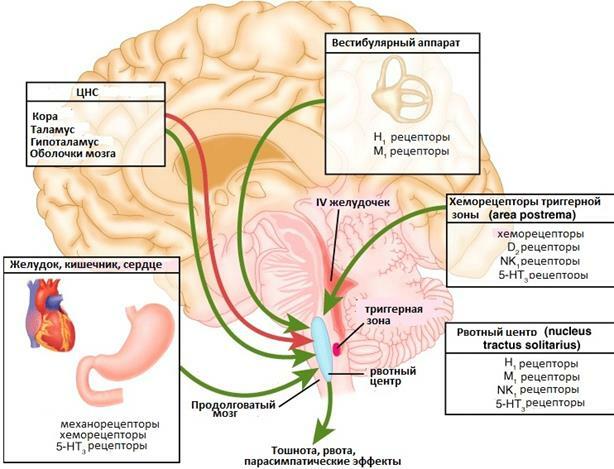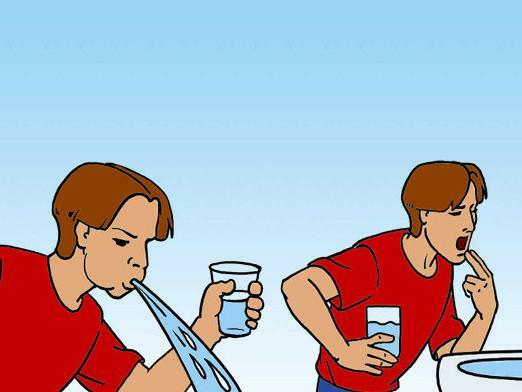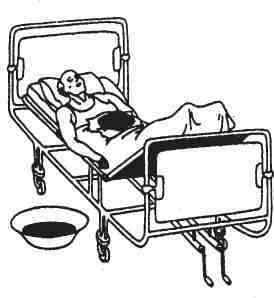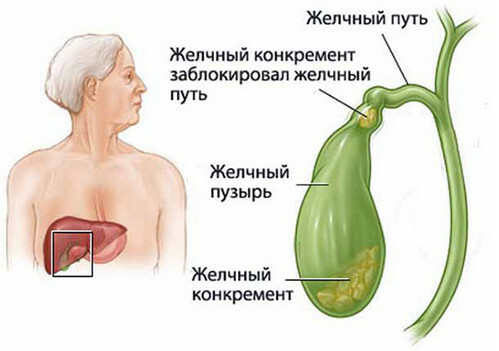Vomiting as a symptom: possible causes, treatment and emergency care
 Vomiting is a response to the process of excitation of a specific center of the medulla oblongata.This irritation of the brain region is due to the penetration of poisons, or reflexively - from the organs.Usually a harbinger of vomiting becomes nausea.
Vomiting is a response to the process of excitation of a specific center of the medulla oblongata.This irritation of the brain region is due to the penetration of poisons, or reflexively - from the organs.Usually a harbinger of vomiting becomes nausea.
Vomiting mechanism
Vomiting may accompany:
- pathological processes of the gastrointestinal tract;
- disorders of cerebral circulation;
- thrombosis of the vessels of internal organs;
- tumor neoplasms;
- acute kidney disease;
- Toxicoses( gestosis) of the first half of pregnancy;
- infectious( most often intestinal) diseases;
- disease of the visual organs;
- vestibular disorders;
- acute forms of myocardial infarction;
- overdose of medicines, incompatibility of medicines.
In the patient, initially there is nausea, excessive salivation, breathing becomes quicker.Then the diaphragm descends and the stomach section, which passes into the 12-colon, starts to shrink in the opposite direction( antiperistaltic), the upper "floor" on the contrary relaxes.Diaphragm spasms start, the pressure in the cavity of the stomach rises, the voice gap closes.After this, there is an eruption of the gastric contents through the esophagus into the oral cavity.

Patient pale, it has a cold, sticky sweat, often comes dizziness and severe weakness, blood pressure may fall.Nausea is a feeling that arises from the irritation of the wandering and celiac nerves.Excitation from them is transferred to the vomiting center and from it the impulse goes to the organs that are involved in vomiting.
As a matter of fact, vomiting is a definite symptom, but depending on the causes of the onset and a number of other factors, it has many varieties and features of leakage.
Features of vomiting:
- vomiting not accompanied by nausea is characteristic of problems with the brain;
- vomiting with severe headache is a sign of migraine;
- vomiting in the morning is typical for poisoning.
Symptoms of vomiting in pathological changes of the digestive tract
Begins with attacks of nausea, sometimes with concomitant pain.
Esophageal vomiting
Begins without nausea, lying down or tilted forward.It occurs because of the delay and accumulation of food in the esophagus.
Nutritional vomiting is typical for the following diseases:
- narrowing of the esophagus( tumor, post-burn, ulcerative);
- achalasia of the cardia( spastic tension of the lower part of the esophagus);
- diverticula of the esophagus( saccule protrusion of the walls);
- Deficiency of the sphincter( muscle compressing the passage from the esophagus into the stomach).
In terms of the timing of the onset,
- gives early vomiting that occurs during eating, with pain behind the sternum.It is provoked by the use of solid food for problems in the esophagus;
- late vomiting, manifested 3-4 hours after eating( a sign of a strong expansion of the lower parts of the esophagus);
- mixed.It occurs with ulcerative esophagitis( inflammation of the esophagus with ulcers).
Sometimes there is night vomiting.Complicated by getting into the respiratory tract.
Signs of vomiting in diseases of the stomach and duodenum
Gastric vomiting manifests itself almost immediately after a plentiful meal, with the pathology of the 12-colon - after 2-3 hours.
Note: is a distinguishing feature - relief immediately after vomiting and pain reduction.
The narrowed opening of the output( pyloric) part of the stomach( with cancer, cicatricial changes) causes frequent, voluminous vomiting with undigested food, which is in the stomach for several days, with putrefactive odor.
If vomiting is repeated often, it contains the remains of freshly eaten food, then a spasm of the lower part of the stomach should be suspected.It occurs when poisoning with toxins, an acute ulcerative process in the stomach, diseases and dyskinesia of bile ducts, neuroses.
In cases of acute gastritis, patients often complain of vomiting - multiple, with pain in the epigastric region, bringing relief.Chronic gastritis is very rarely accompanied by vomiting.
Symptoms of vomiting with intestinal obstruction
Vomiting begins with the onset of severe, spasmodic and paroxysmal pain in the abdomen of a diffuse nature.Intestinal obstruction in the upper parts is the cause of vomiting of bile.Obstruction, localized in the large intestine, manifested by vomiting.A similar complaint in the patient is available in the presence of a stroke( fistula) between a number of located stomach and the loop of the large intestine.
Other diseases of the abdominal cavity giving vomiting
 Acute appendicitis can also give vomiting, especially if there are severe pains and fever.
Acute appendicitis can also give vomiting, especially if there are severe pains and fever.
Thrombosis of the peritoneal arteries is accompanied by vomiting with blood.
With peritonitis( inflammation of the peritoneum), repeated vomiting and fever are observed, which brings relief each time.
Vomiting caused by diseases of the liver, pancreas, gallbladder and ducts
In these diseases, vomiting is often repeated, it is accompanied by pain in the zone of the right hypochondrium.In patients, jaundice of the skin, sclera of the eyes, especially after a violation of diet and the intake of fatty foods.Diseases with focal changes of the gallbladder, ducts, cause vomiting of bile.
Acute pancreatitis is manifested by simultaneous vomiting and paroxysmal pain in the upper abdomen.During an attack, vomiting can begin with blood, often indomitable.
Infectious hepatitis often occurs with vomiting and fever, accompanied by pain in the right upper quadrant, an increase in the liver, the development of icteric skin in patients.
Vomiting in endocrine diseases
Diabetic coma can occur with severe diabetes.These are formidable complications of this disease, requiring immediate assistance.Vomiting is a frequent companion of this pathology.
Chronic adrenal insufficiency and hyperparathyroidism are also characterized by the presence of vomiting.
Poisoning
Intoxications that occur for various reasons in humans( infectious diseases, industrial poisoning, domestic poisoning) can give vomiting and diarrhea without fever or with various kinds of fevers.
Important: vomit in any case of intoxication undergo mandatory laboratory testing.
Phenomena of cerebral vomiting
Occurs as a result of injuries and diseases of the brain, vessels and surrounding tissues.Increased pressure in the diplic veins of the skull( intracranial pressure) gives characteristic vomiting with intense headache, arising in the mornings, when trying to stand up or simply turning the head lying down.These signs can be accompanied by a violation of the heart and breathing.Possible loss of consciousness( Bruns syndrome).
Vomiting and temperature are typical for inflammatory diseases of the brain and membranes - meningitis and encephalitis.In these cases, too, there is an intense pain in the head, specific neurological symptoms, which is determined by a neuropathologist.Possible development of paresis and paralysis.
Ménière's disease is accompanied by a lesion of the vestibular apparatus with dizziness, dull hearing and occasional vomiting.
Many people suffering from hypertension have a sudden increase in blood pressure and deterioration accompanied by nausea and vomiting.
How to induce vomiting
In some diseases and conditions, it is necessary to be able to induce vomiting yourself.In case of overeating, poisoning, eating poor-quality food or water, it may be necessary to empty the contents of the stomach, causing compulsory vomiting.
The most commonly used method is the pressure on the root of the tongue with two fingers, or a spoon.To facilitate the procedure, it is better to drink a solution of manganese.It is prepared from a small amount of potassium permanganate crystals and a liter of warm, boiled water.The solution must be mixed until a pink, uniform color is obtained.Then drink it, stimulate vomiting.The solution helps to rinse the stomach well, clean it.Also, unpleasant sensations during vomiting are relieved.

For the same purpose, you can use a solution of salt and soda in water( 1 teaspoon per liter).Take a volley and empty your stomach.In most cases, there is relief.
Vomiting in children
 Vomiting in a child is a common symptom that accompanies many childhood illnesses.
Vomiting in a child is a common symptom that accompanies many childhood illnesses.
As with adults, it happens:
- is psychogenic;
- is an organic( caused by diseases).
In newborns in the first months of life, vomiting can occur due to excessive food intake.Often it is accompanied by ingestion of air.
Note: sometimes occurs "chewing gum" - regurgitation with repeated ingestion( rumination).Regurgitation is different from vomiting by the lack of muscle tension.
Vomiting in children is accompanied by:
- diseases of the gastrointestinal tract;
- infectious diseases;
- poisoning;
- heart and vascular disease;
- pathology of the nervous system.
The child has cases of vomiting and diarrhea without the temperature of unexplained etiology or as the first( single) symptoms of the onset of the disease.
Diarrhea, vomiting and fever often accompany an infectious pathology.Vomiting with blood( scarlet and dark), presence in the masses of mucus, food remnants, intestinal parasites - is a valuable diagnostic feature that allows the pediatrician to correctly build the tactics of diagnosis and subsequent treatment.
Important: requires mandatory identification of cause - vomiting of bile.In children, it is a sign of serious illness.What should I do if I vomit in children?
The answer is in the video review:
First aid measures and methods for the treatment of vomiting
The amount and nature of care is necessarily taken into account depending on the causes that caused vomiting.
Most cases require immediate gastric lavage, causing artificial vomiting.Categorically it is contraindicated to inject a patient with antiemetic drugs.
 If there is blood in the vomit, then the stomach should not be washed.The patient can be given to take small pieces of ice inside, on the epigastric region it is better to put an ice bladder.An urgent hospitalization is necessary in a recumbent position.
If there is blood in the vomit, then the stomach should not be washed.The patient can be given to take small pieces of ice inside, on the epigastric region it is better to put an ice bladder.An urgent hospitalization is necessary in a recumbent position.
Atropine or metaclopramide can be used subcutaneously to stop vomiting.With indomitable vomiting, neuroleptics( etaperazine, meterazine, haloperidol) are prescribed.
Treatment of repeated vomiting with severe dehydration is supplemented by intravenous drip of isotonic solution, glucose, other drugs.
Such patients are subject to hospitalization.
Alexander Lotin, radiologist,



